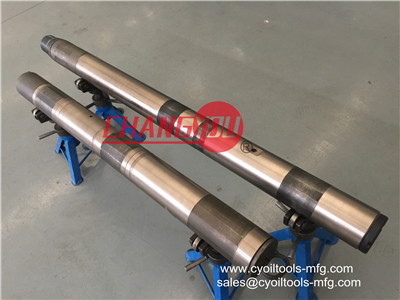HOME >> News >> Industry Information
Drill stem test,DST |
[ Time:2018-09-03 | Hits:644 ] |
| Originally, the objective of a drill stem test was to take a representative fluid sample which, in the very early days of the oil industry, was obtained by either bailing or swabbing. Following the introduction of a packer and a downhole valve, the next step was the possibility of recording accurate bottomhole reservoir pressures and temperatures. With the development of downhole tools, which operated on annulus pressure and a downhole shut-in valve with surface read-out, drill stem testing has become a generally accepted safe method to meet the original objectives; to obtain a fluid sample and reservoir data. In a drill stem test, information on the following parameters can be obtained: Reservoir fluid type and properties Production rates and potential production problems Initial reservoir pressure Effective permeabilities Type of flow system A drill stem test is the temporary completion of a well to gather reservoir data. The three fundamental components are a retrievable mechanically set packer, a downhole valve assembly (DST tools) and drill pipe/tubing to surface. A drill stem test is made by running a bottom assembly, consisting of a mechanically set packer and a tester valve, on the drillpipe or tubing. The tester valve is closed while the drillstring is run, thus pressure inside the drillpipe tubing is low compared to the hydrostatic mud or brine column pressure. To provide some back pressure, the string is usually partially filled with water (water cushion). Once on bottom, the packer is set to isolate the zone to be tested from the mud column and the tester valve is opened by pressuring the annulus to allow formation fluids to enter the test string. After a suitable testing period, the valve is closed by releasing annulus pressure and a pressure build-up occurs below the valve as formation fluids repressurise the area around the wellbore. After an adequate build-up time, additional flowing periods can be made by opening the tester valve again. Before pulling out, a circulating valve is opened by pressurising the string 500 p.s.i. above the tester valve operating pressure. The string content can then be reverse circulated out and the well can be killed. The tool string is usually equipped with very accurate pressure and temperature recording devices and a complete flowing build-up record can be obtained which permits determination of reservoir pressure, permeability and sometimes formation damage.
Barefoot resting is similar to the open-hole test with the exception that the packer used is set is casing and not open hole. A stinger is hung offbelow this packer to reach the zone of interest. In Cased-hole testing, the test duration is hardly affected by chances of sticking as in open-hole or barefoot testing. Also packer seal capability is enhanced and thus, the test design can be more flexible. Both string manipulation and annulus pressure activation can be applied to operate the downhole tools, pending rig type and casing conditions. The disadvantage, of course, is the additional cost of a string of casing and the rig time involved to run and cement the casing in place.
(From netwasgroup) |
